Abstract
The present paper examines the relationship between the development of moral behavior and the development of verbal regulatory processes. Relational frame theory and the distinctions among pliance, tracking, and augmenting forms of rule governance are applied to the domain of moral behavior and its development, in order to identify the specific social and verbal contingencies that are responsible for an evolving moral repertoire. It is argued that moral behavior is controlled by relational and rule-following repertoires, and that these can be arranged into a rough progression: pliance, tracking, augmenting, social concern for pliance, social concern for tracking, and social concern for augmenting. Congruence with data derived from other research traditions is examined, and applied implications are explored.
Keywords: moral behavior, moral development, rule governance, pliance, tracking, augmenting, relational frame theory
Full text
PDF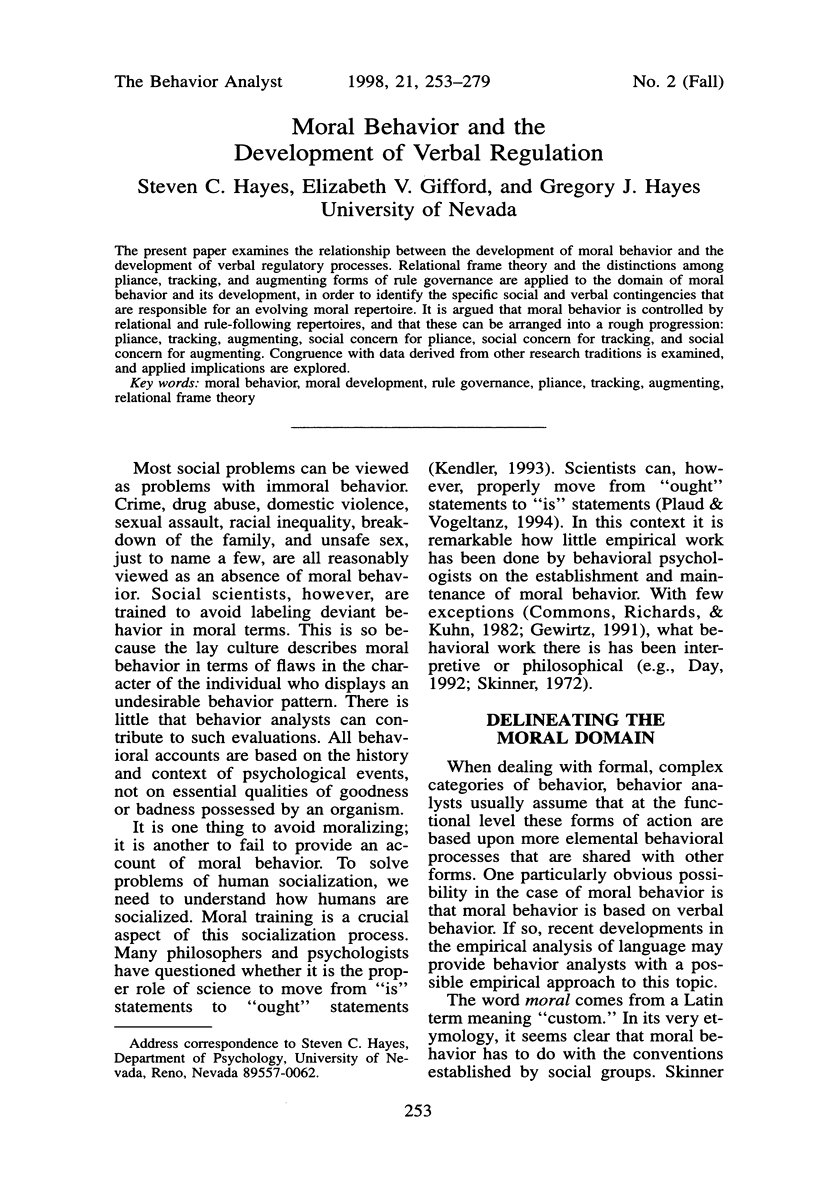
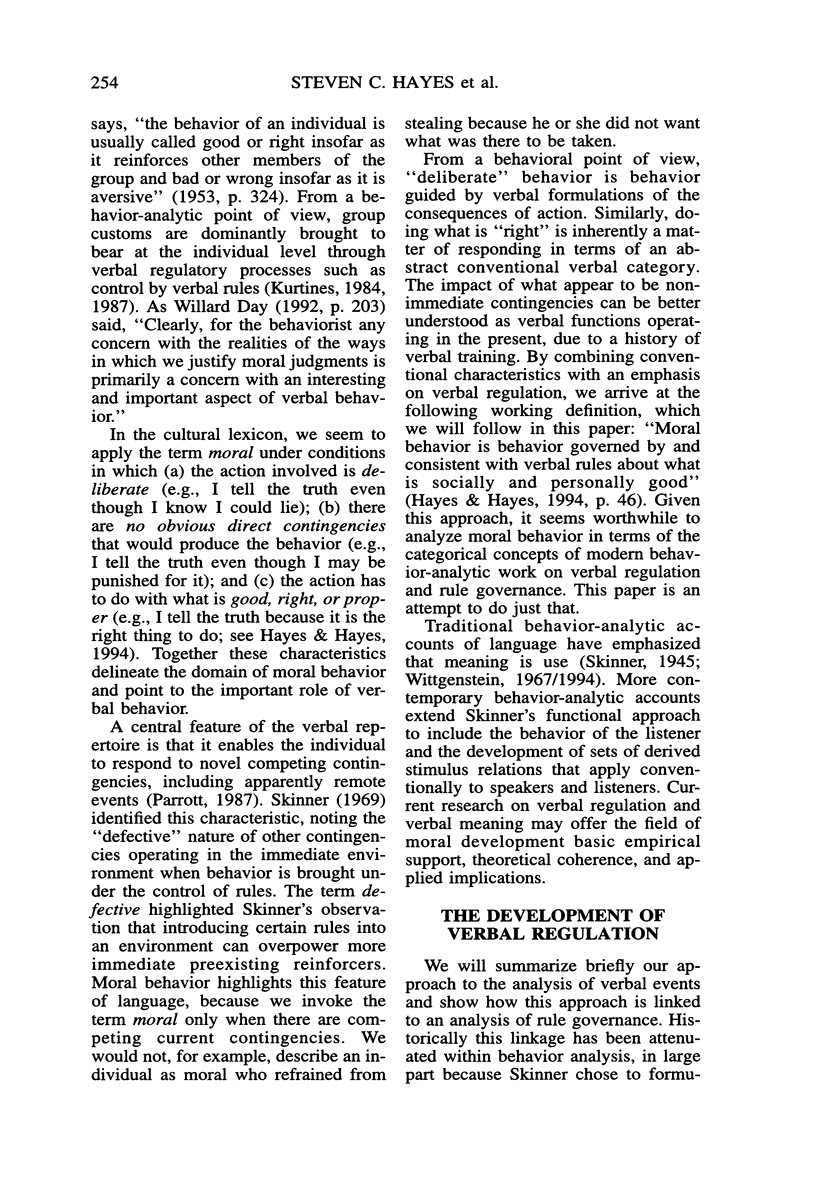
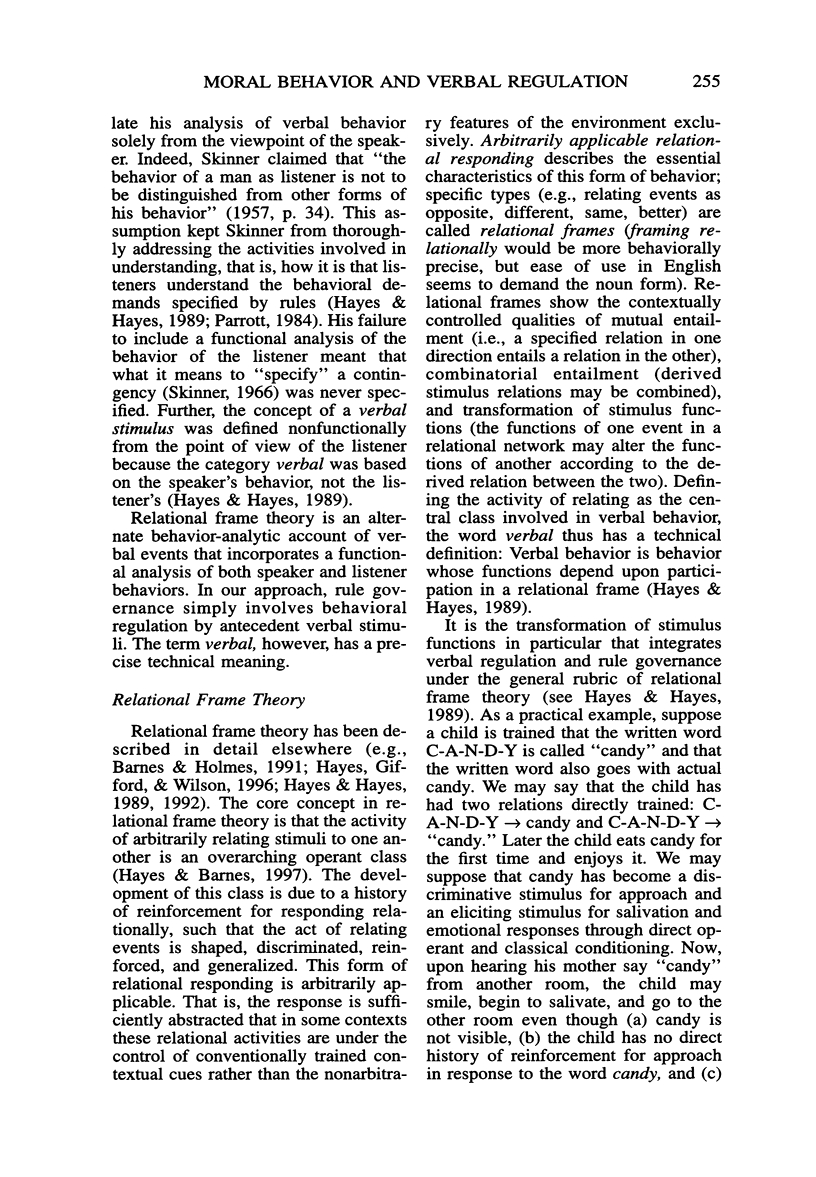
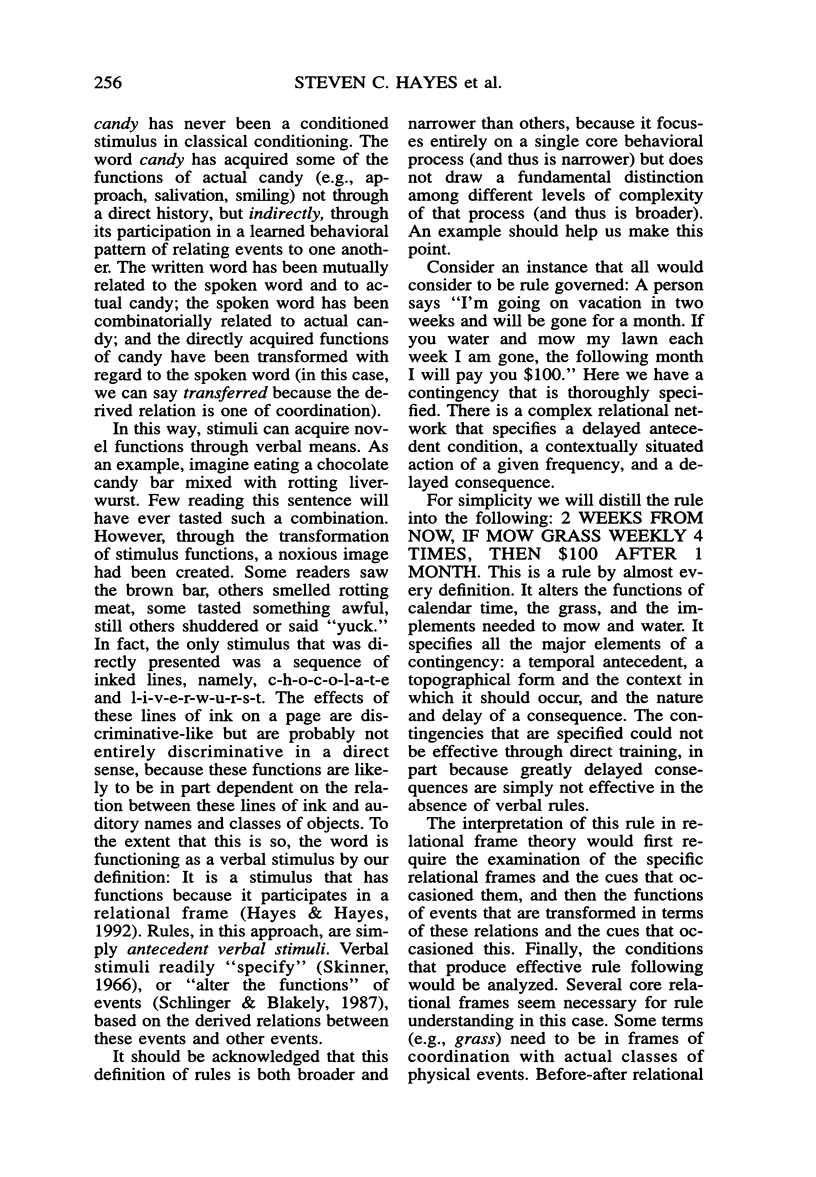
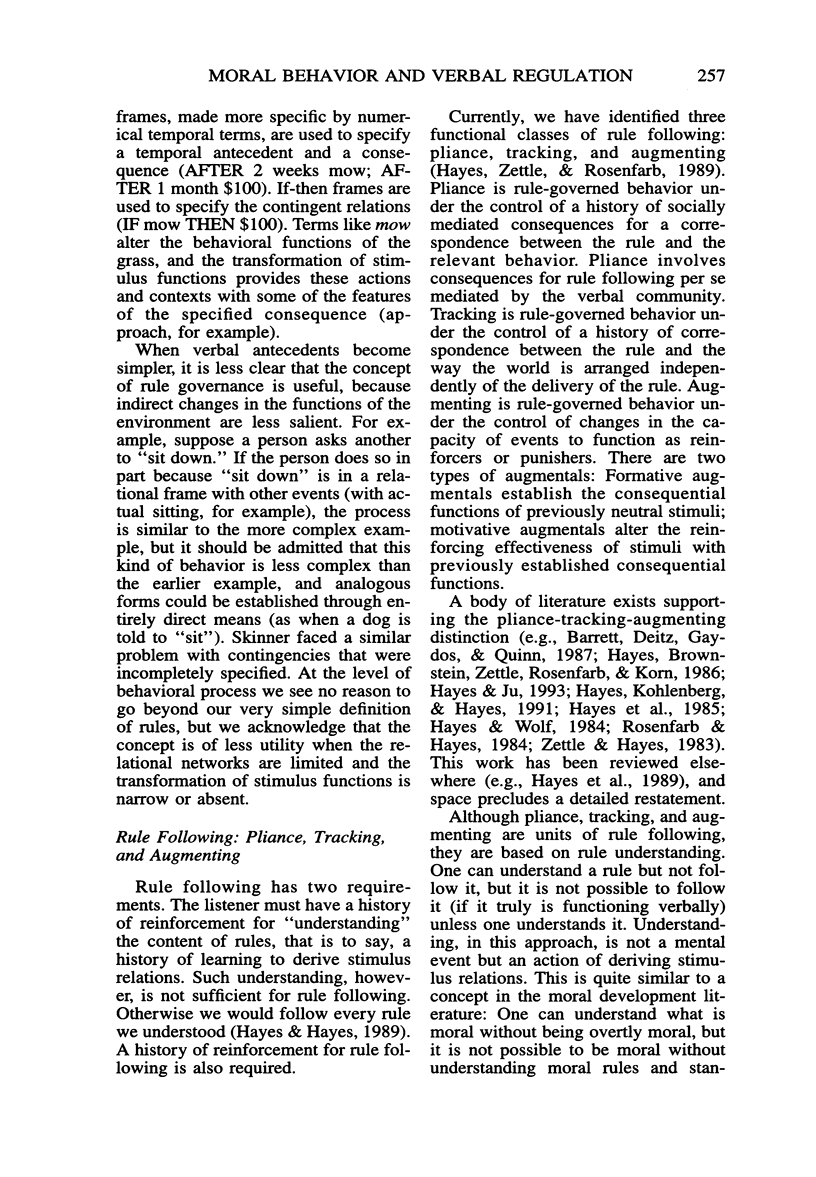
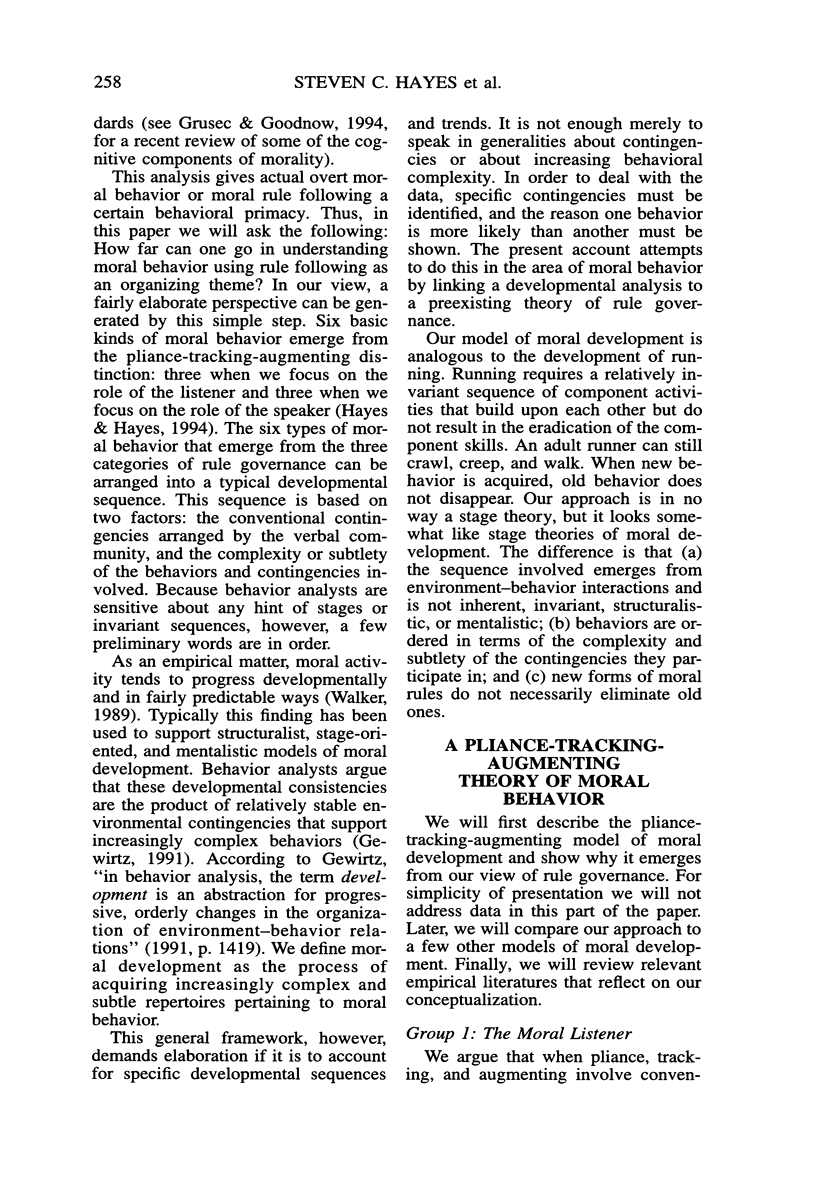
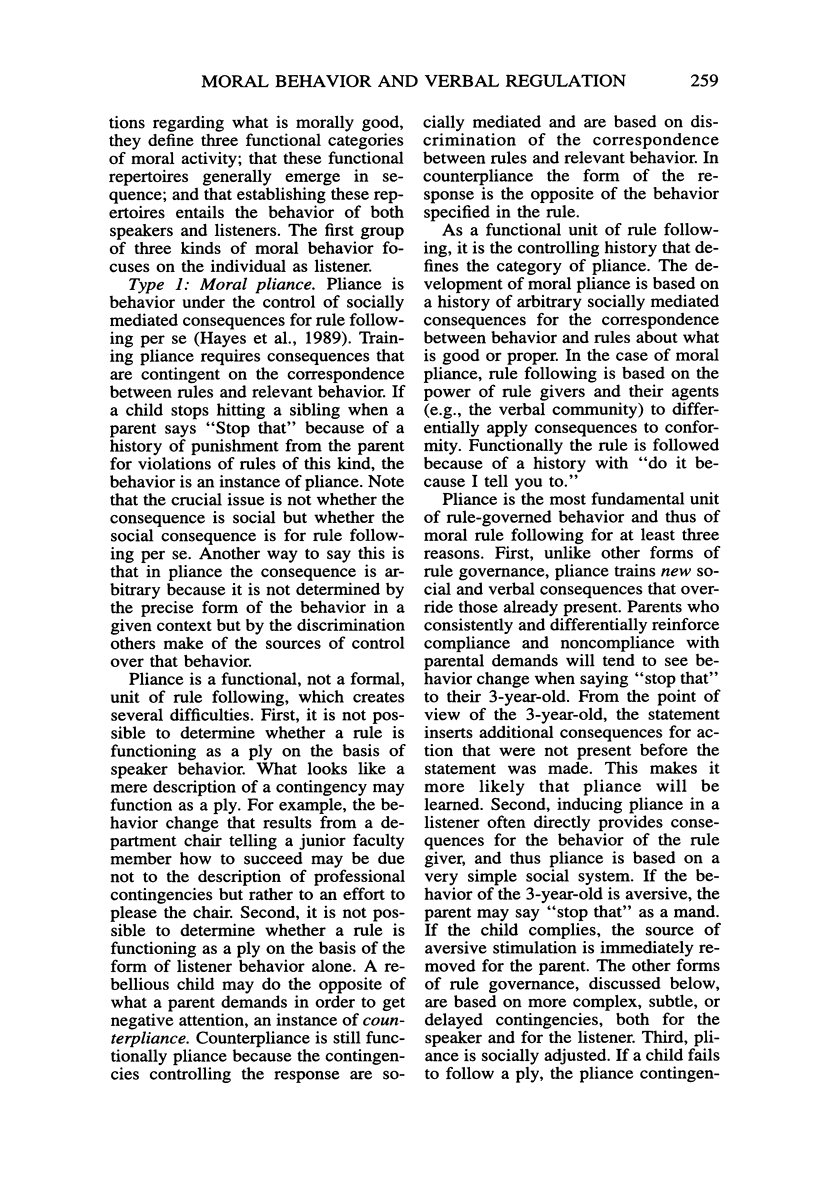
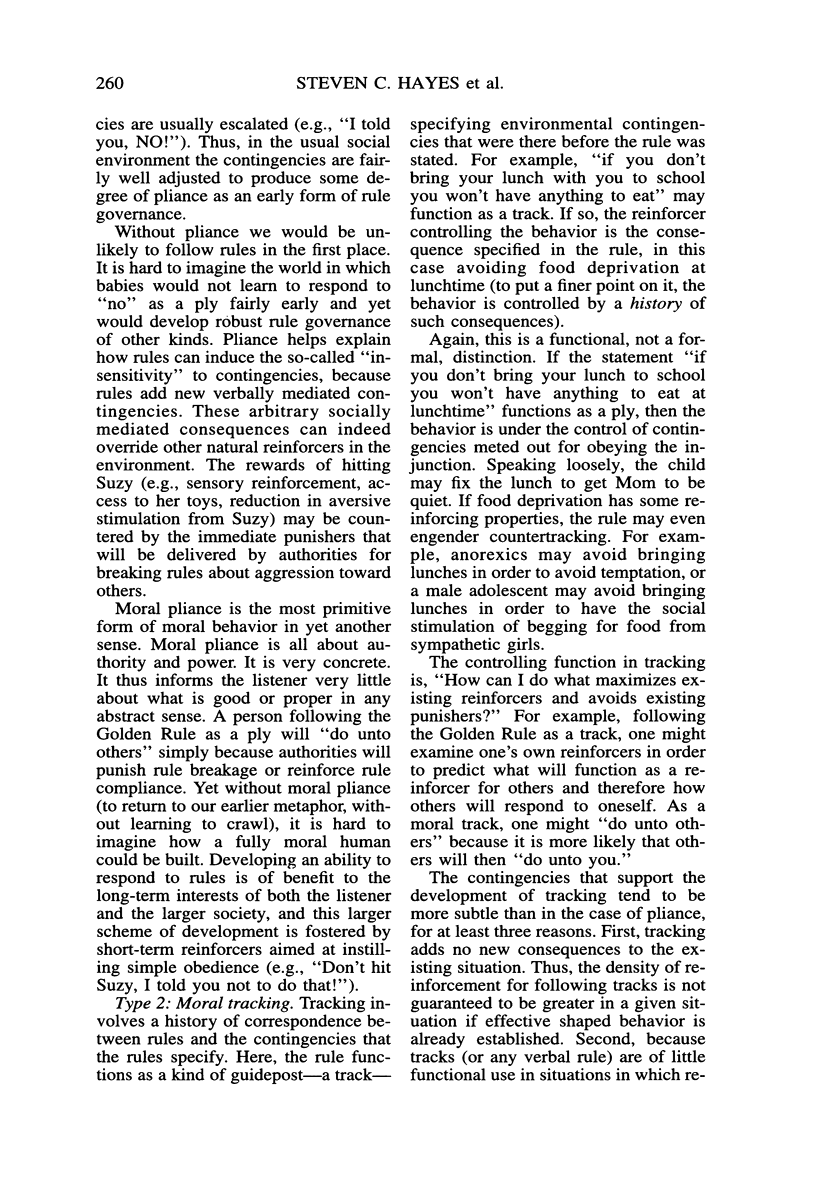
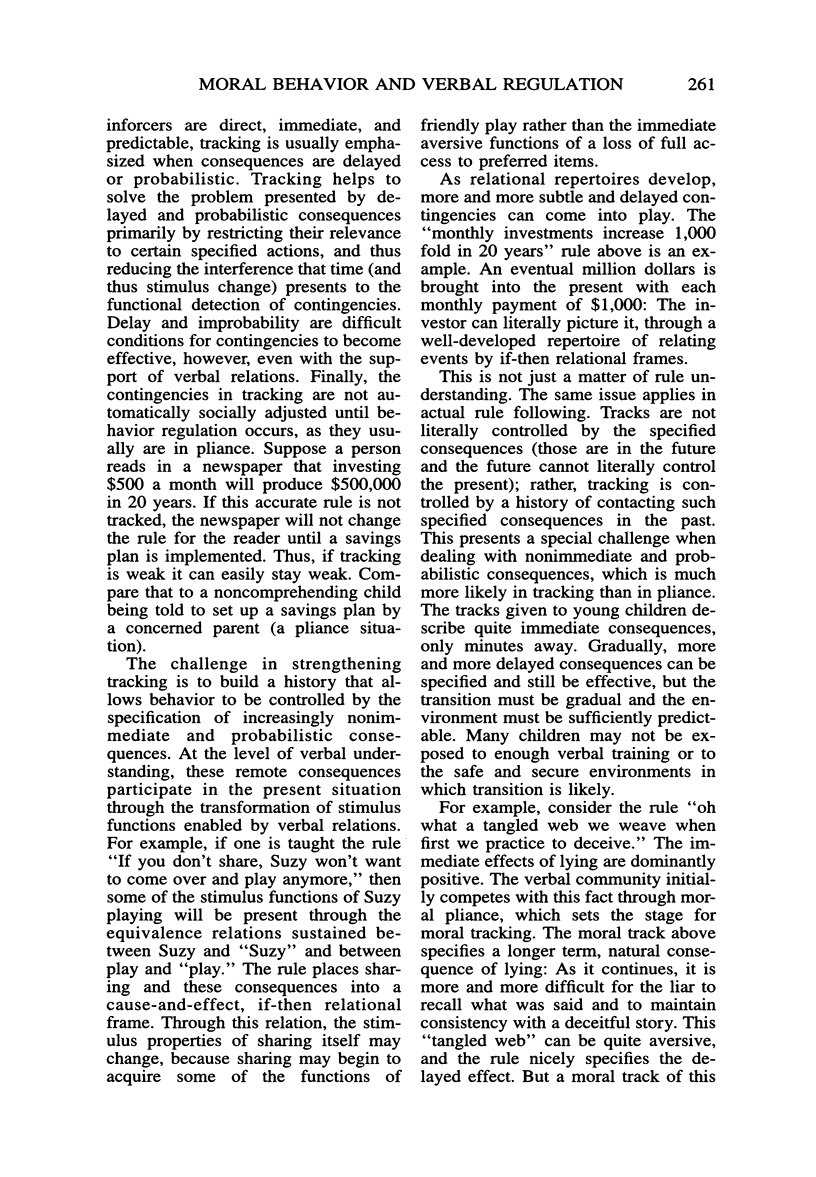
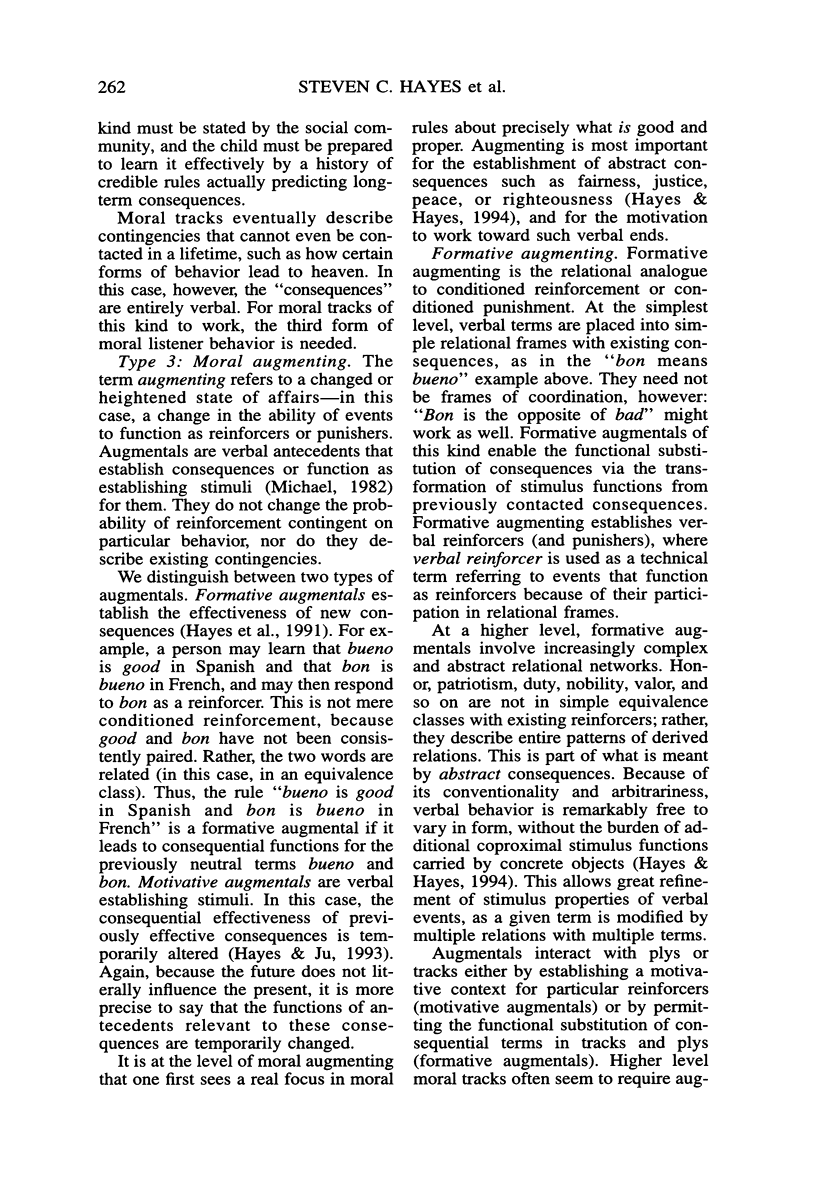
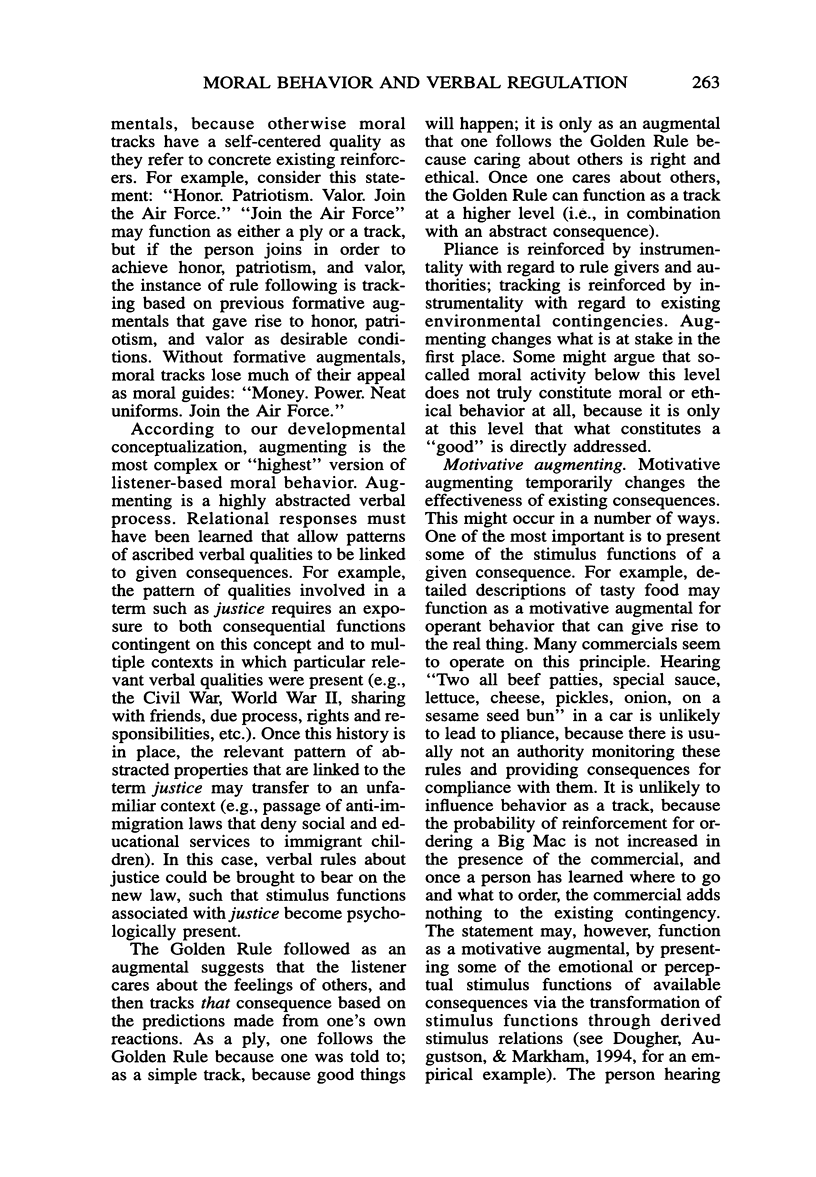
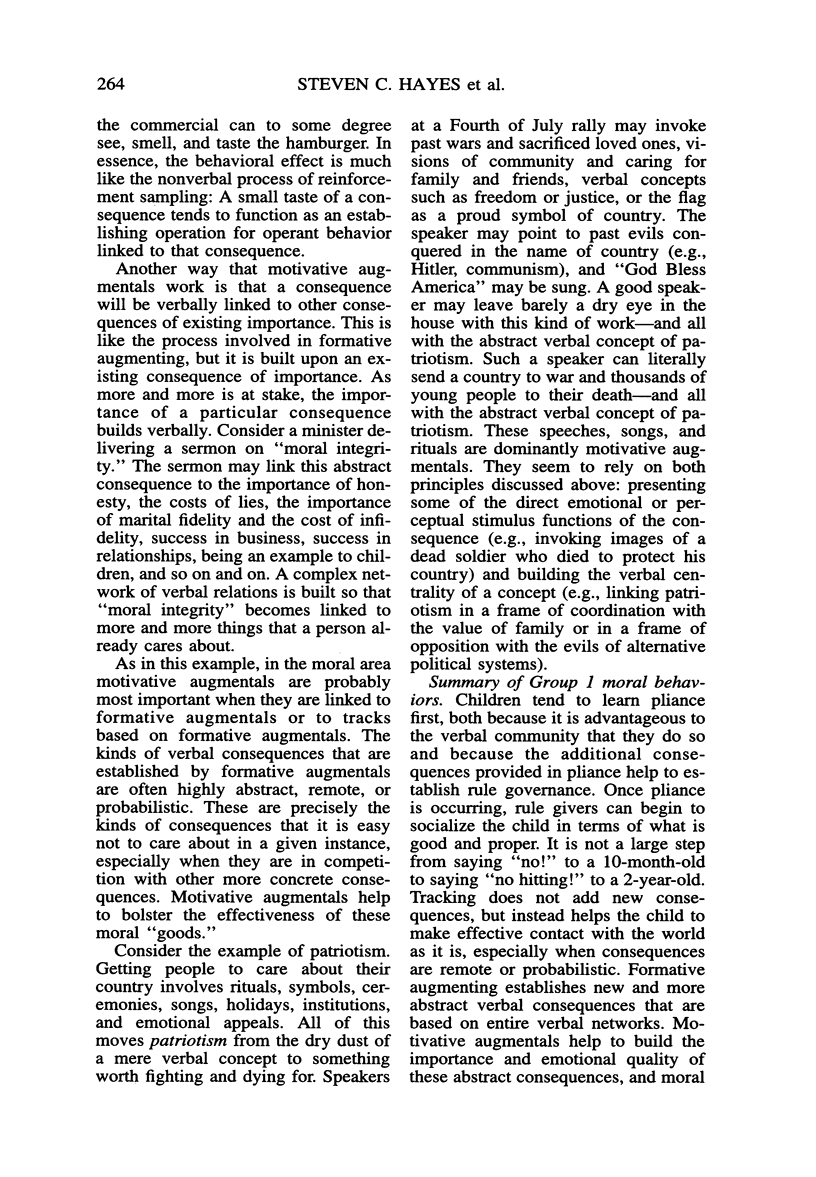
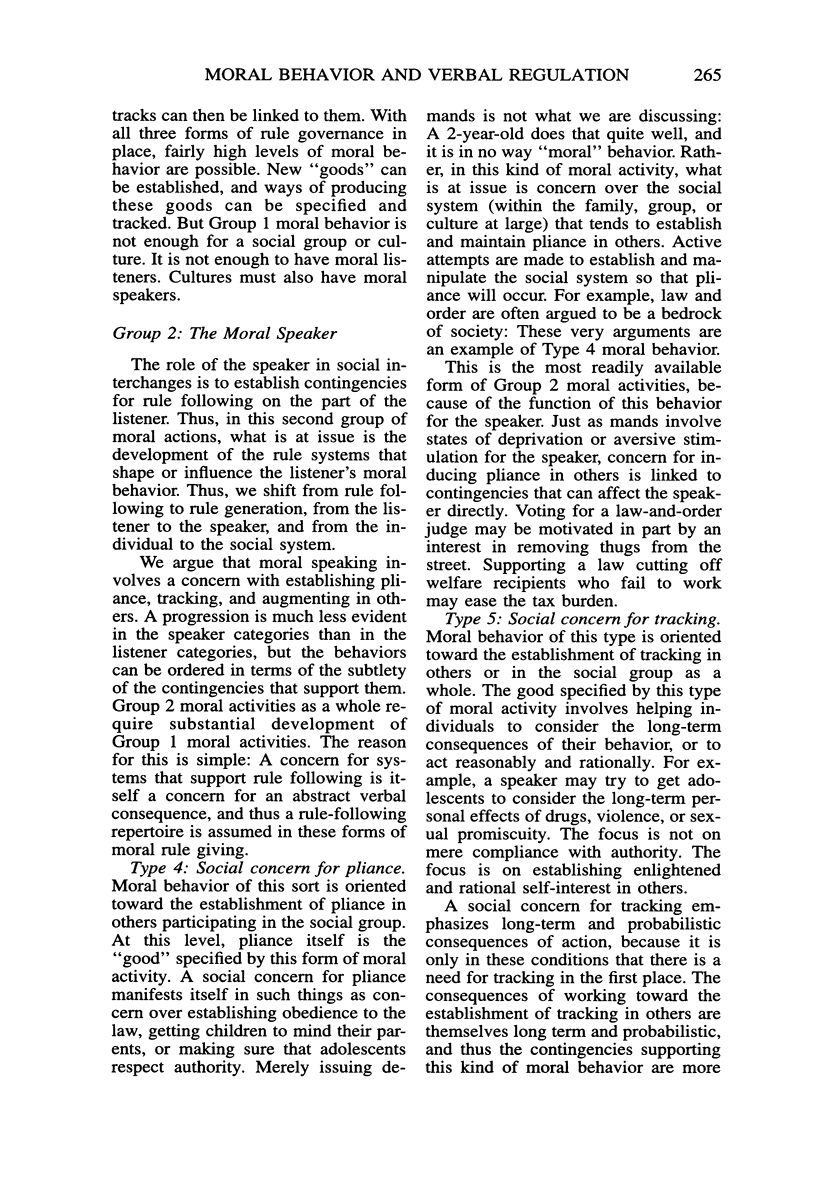
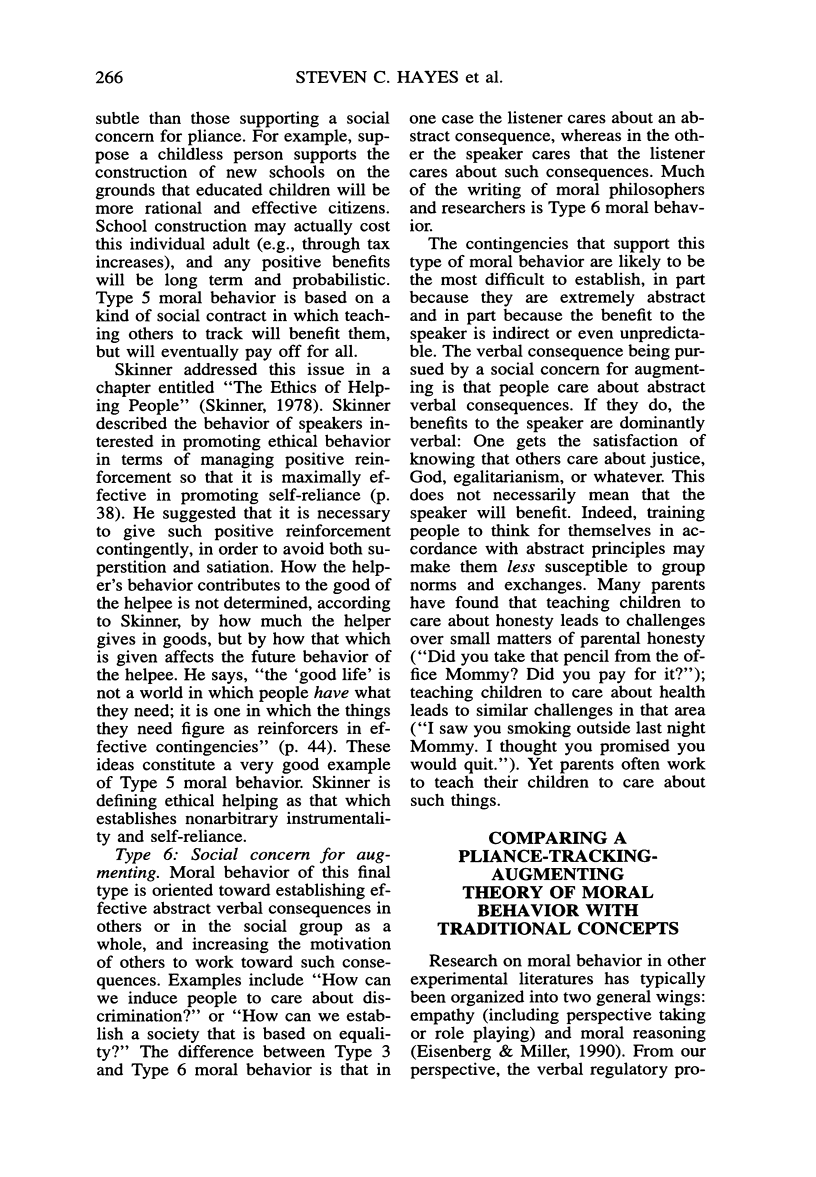
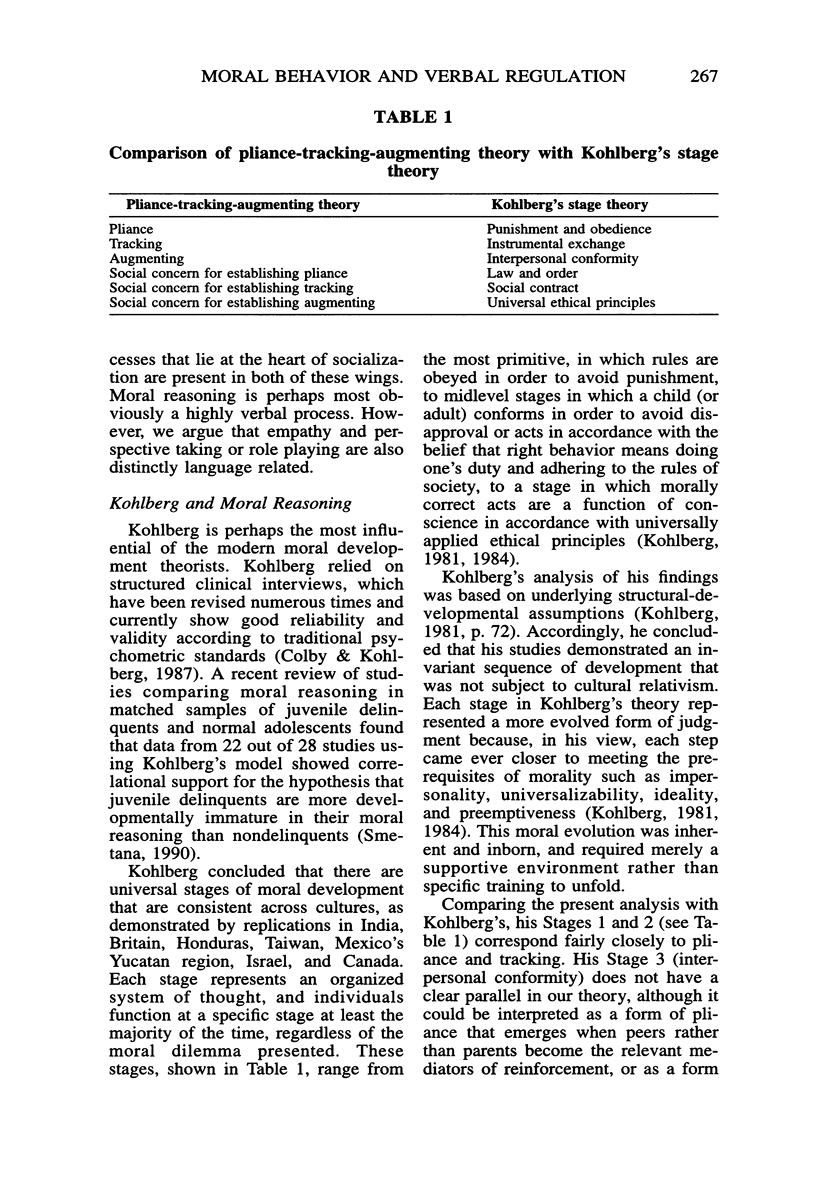
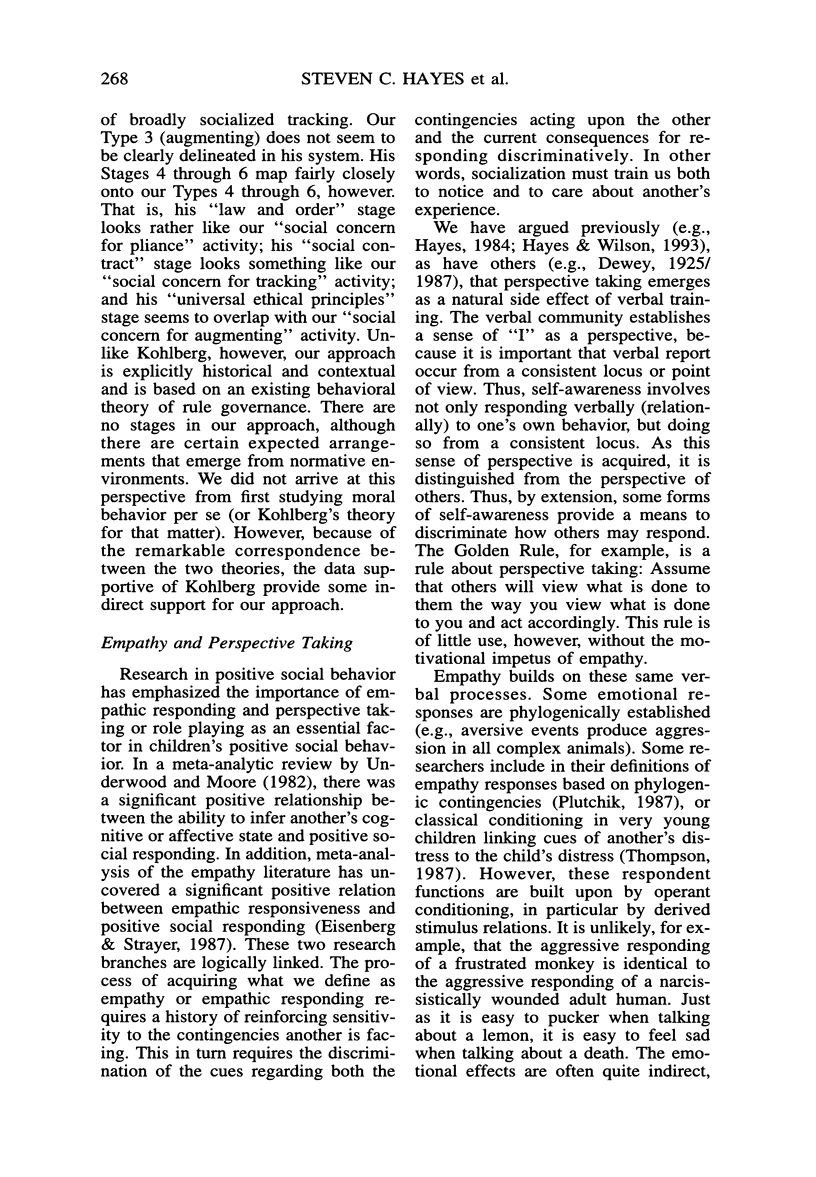
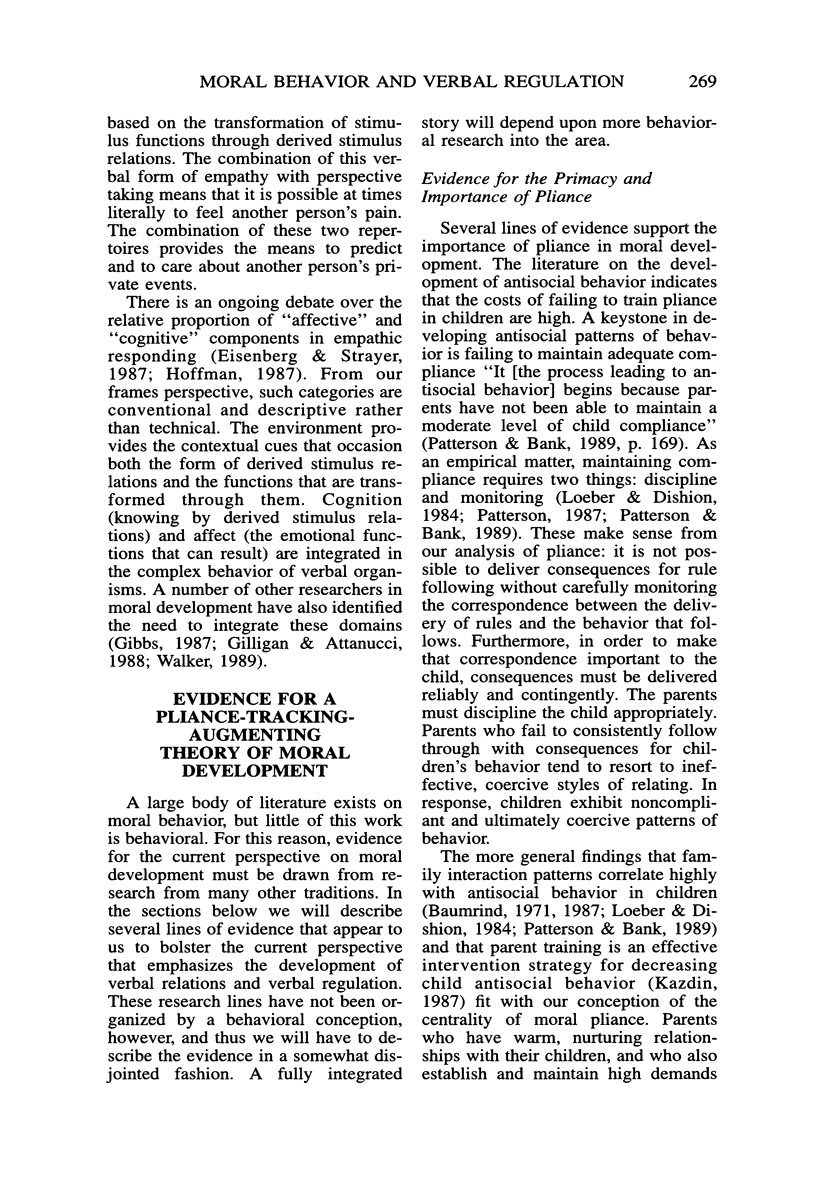
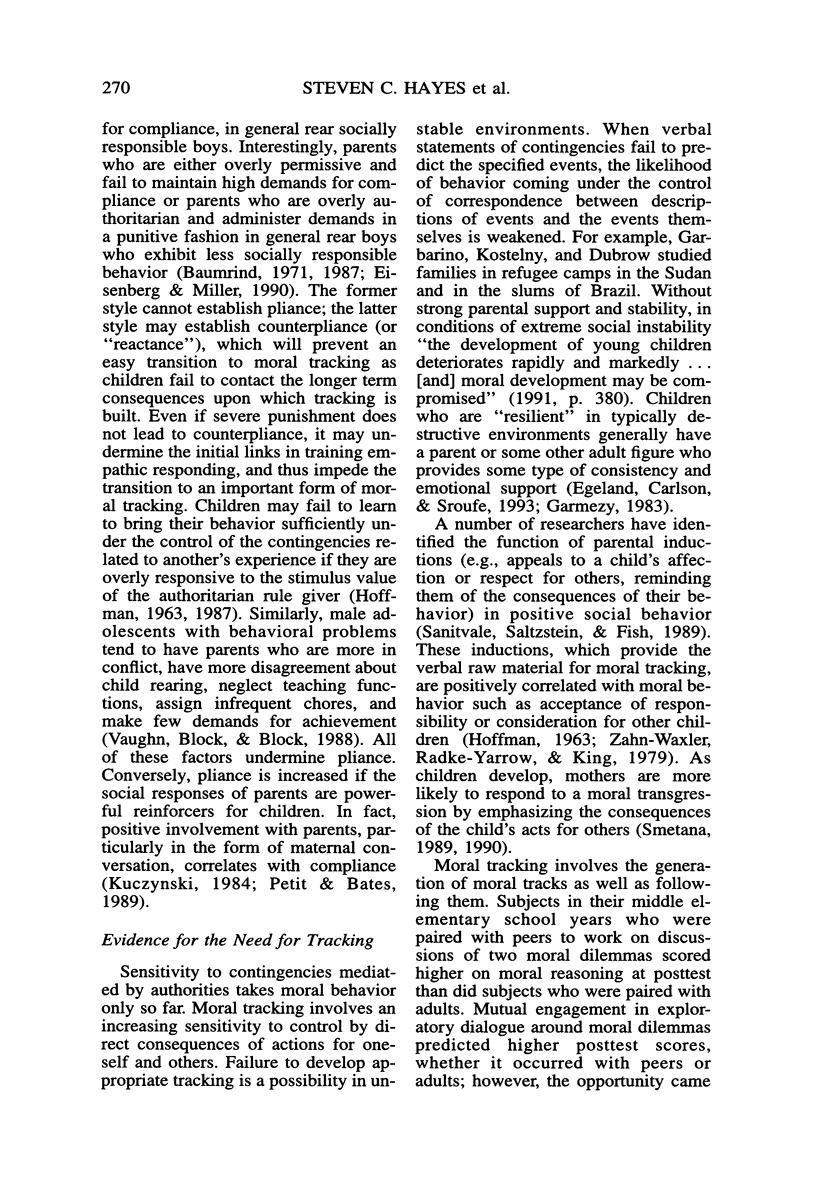
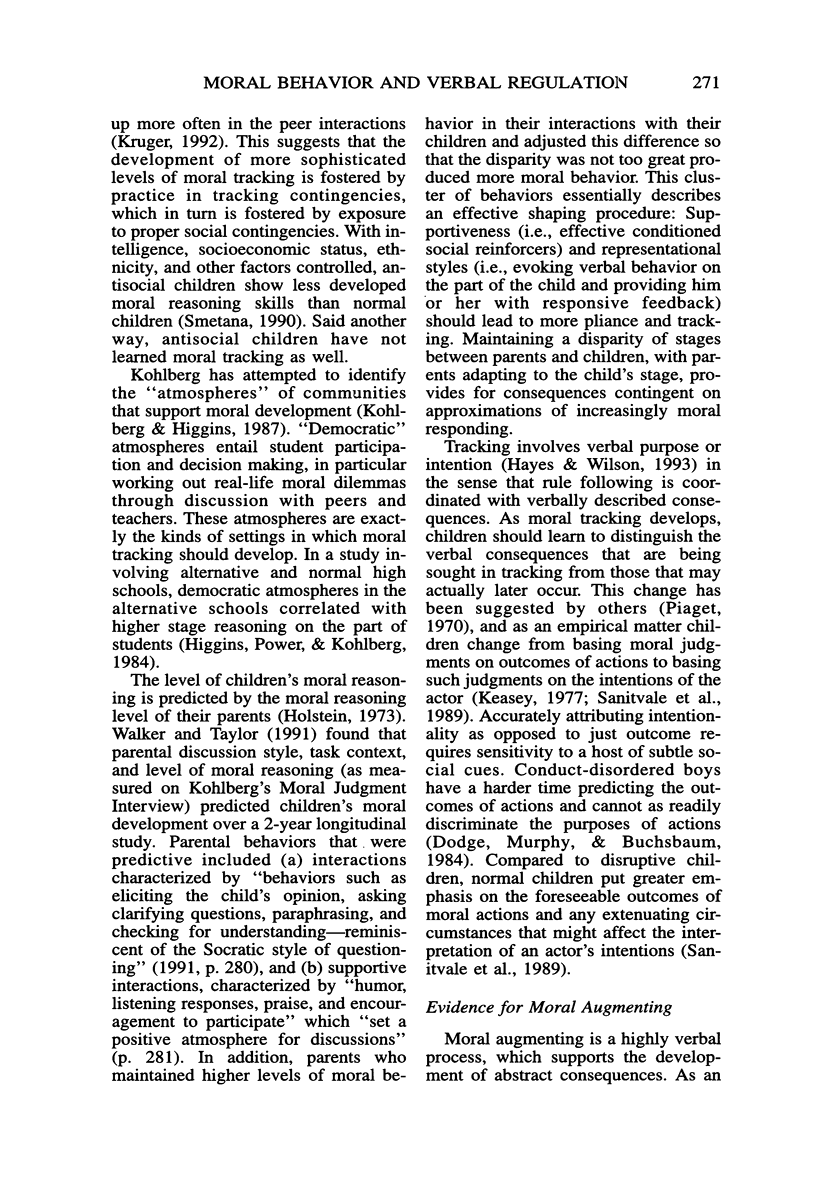
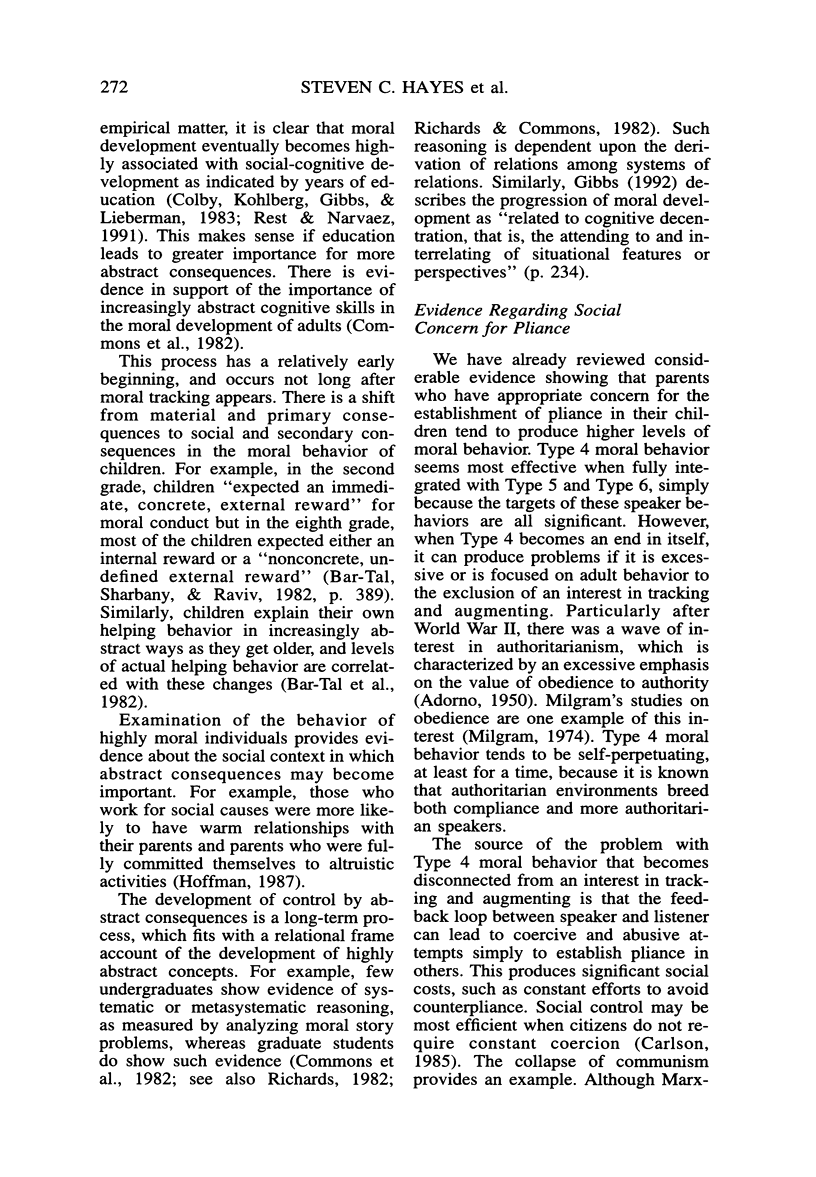
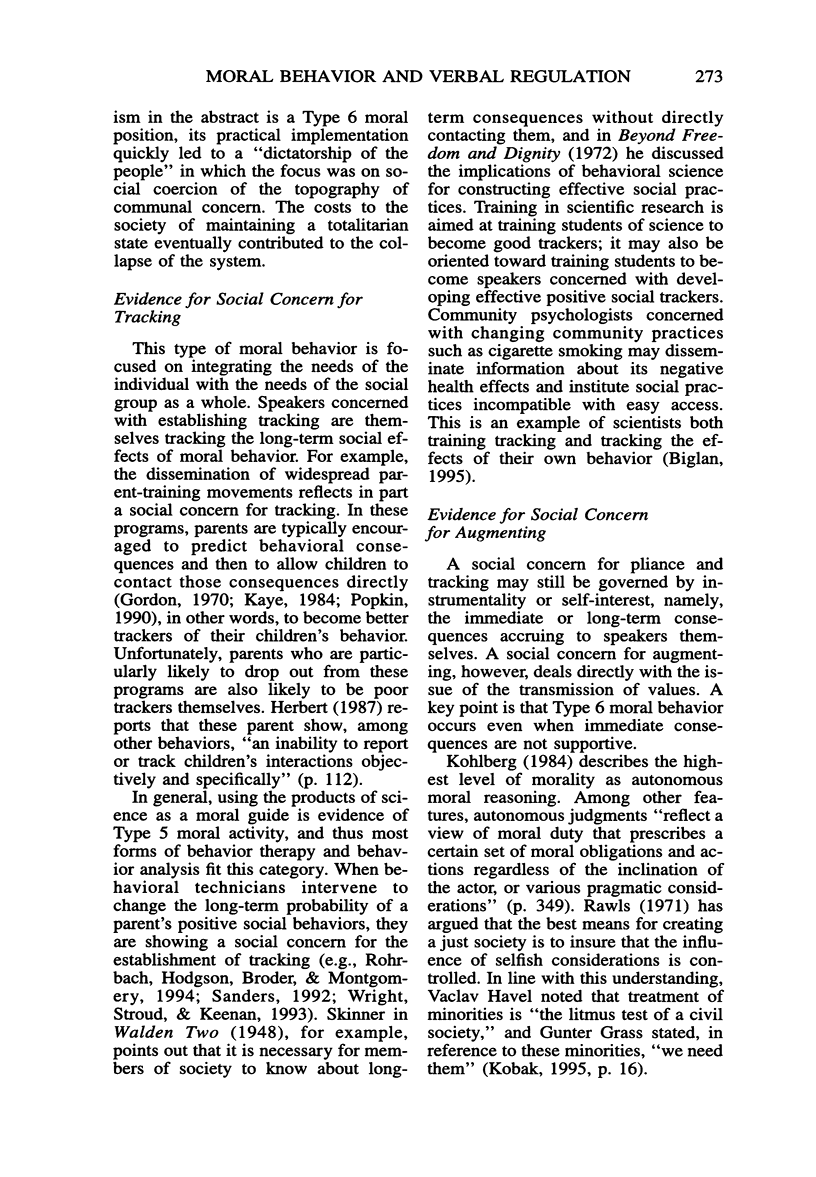
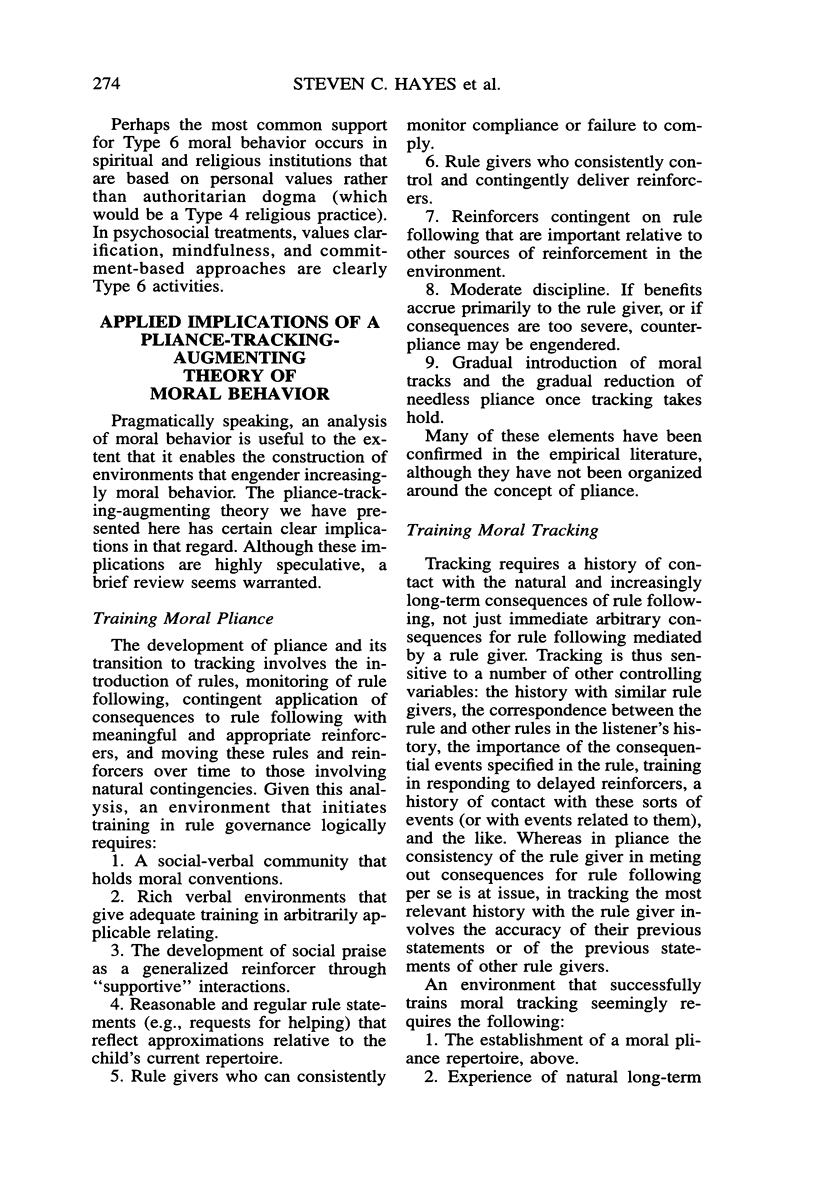
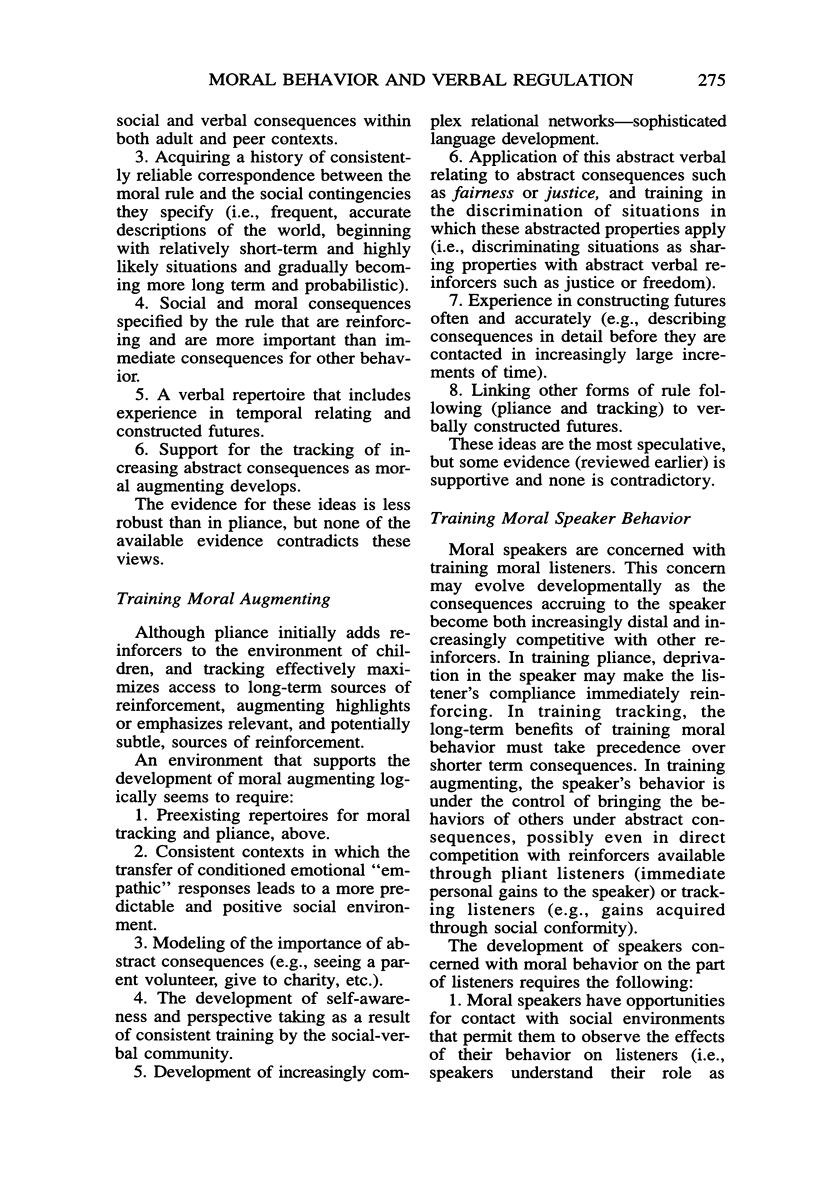
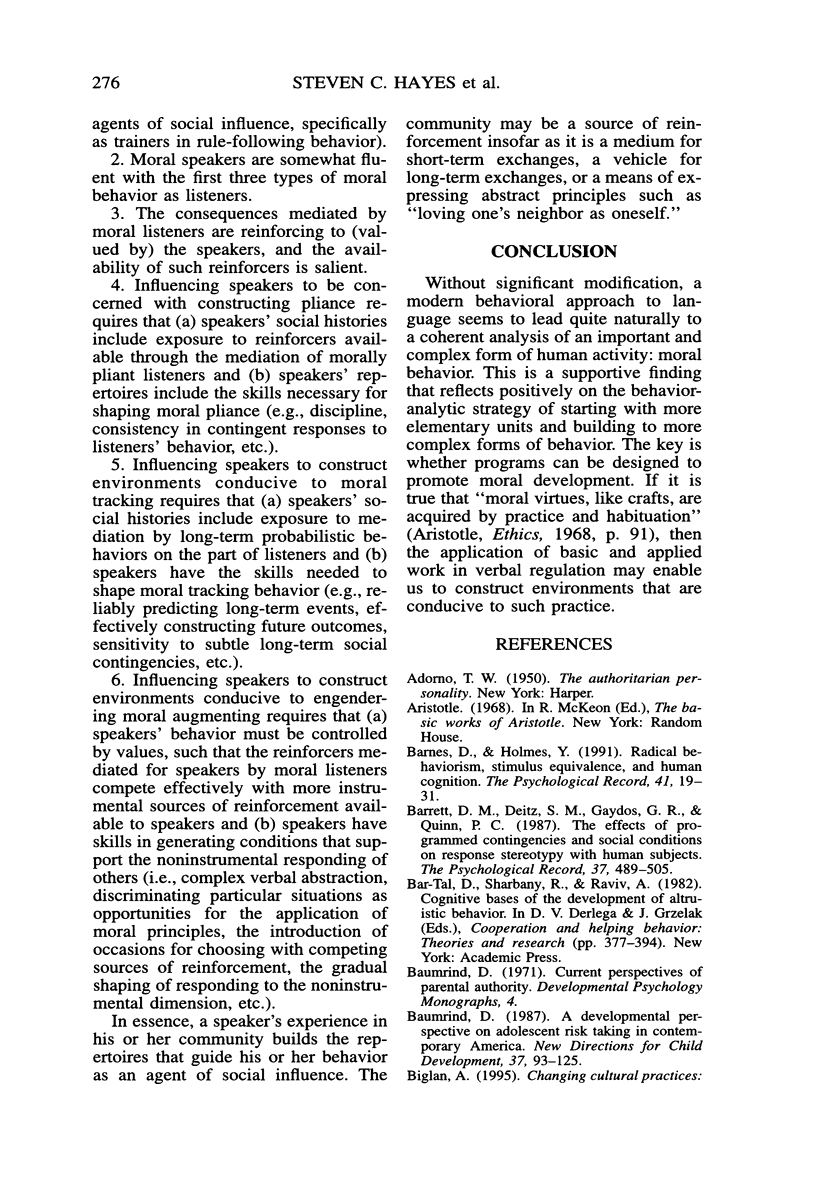
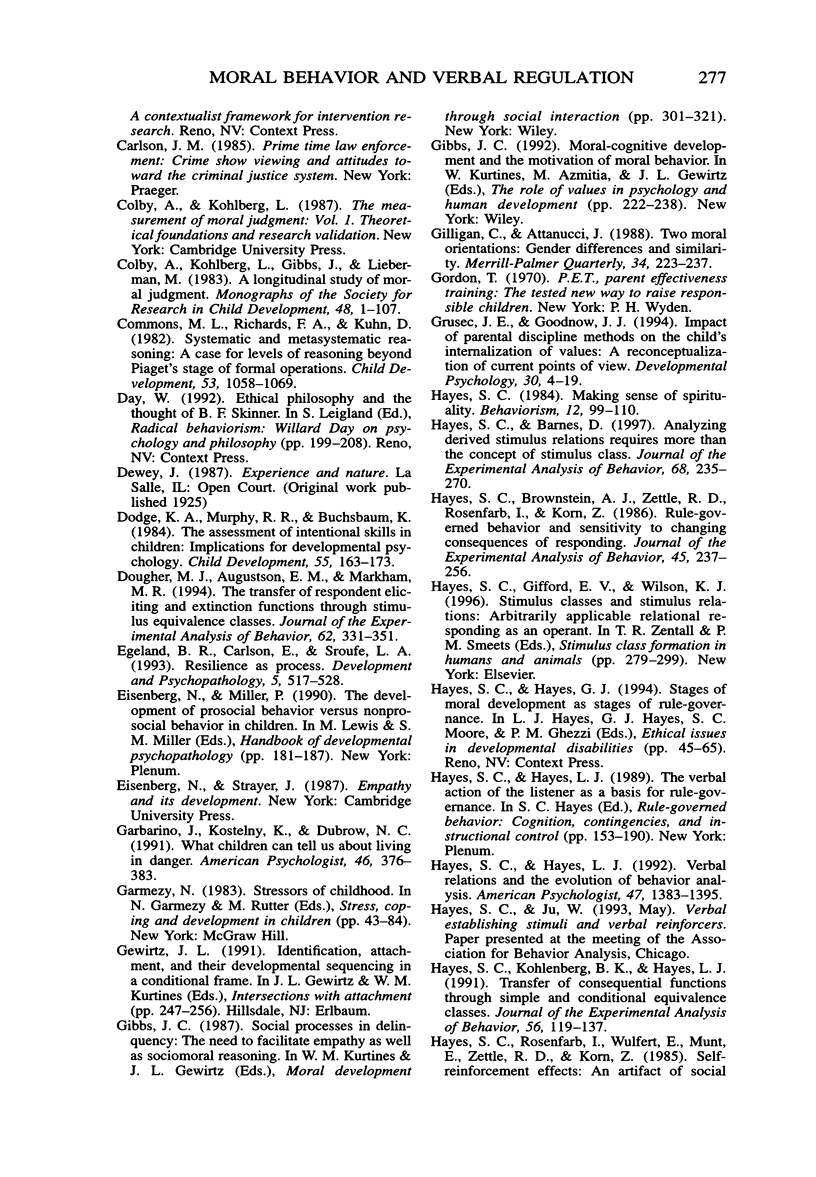
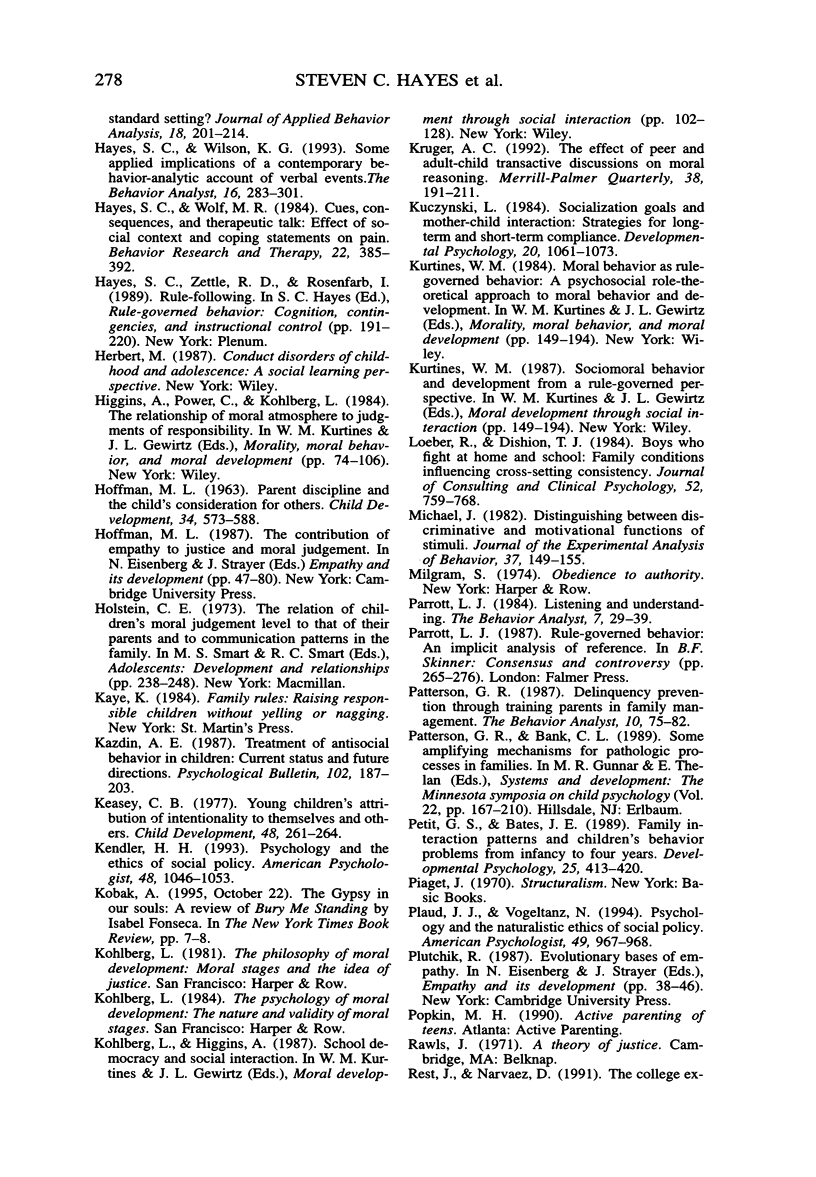
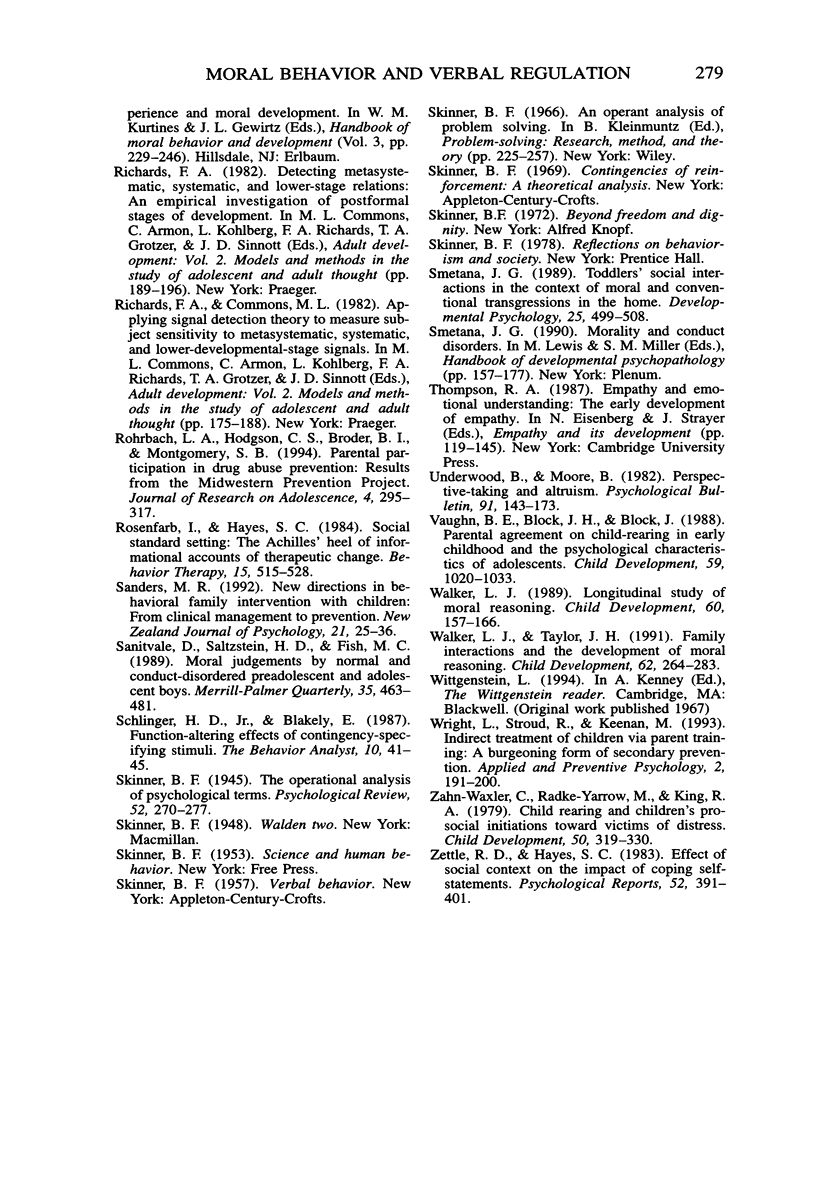
Selected References
These references are in PubMed. This may not be the complete list of references from this article.
- Bank L., Patterson G. R., Reid J. B. Delinquency prevention through training parents in family management. Behav Anal. 1987 Spring;10(1):75–82. doi: 10.1007/BF03392409. [DOI] [PMC free article] [PubMed] [Google Scholar]
- Baumrind D. A developmental perspective on adolescent risk taking in contemporary America. New Dir Child Dev. 1987 Fall;(37):93–125. doi: 10.1002/cd.23219873706. [DOI] [PubMed] [Google Scholar]
- Dodge K. A., Murphy R. R., Buchsbaum K. The assessment of intention-cue detection skills in children: implications for developmental psychopathology. Child Dev. 1984 Feb;55(1):163–173. [PubMed] [Google Scholar]
- Dougher M. J., Augustson E., Markham M. R., Greenway D. E., Wulfert E. The transfer of respondent eliciting and extinction functions through stimulus equivalence classes. J Exp Anal Behav. 1994 Nov;62(3):331–351. doi: 10.1901/jeab.1994.62-331. [DOI] [PMC free article] [PubMed] [Google Scholar]
- Garbarino J., Kostelny K., Dubrow N. What children can tell us about living in danger. Am Psychol. 1991 Apr;46(4):376–383. doi: 10.1037//0003-066x.46.4.376. [DOI] [PubMed] [Google Scholar]
- HOFFMAN M. L. Parent discipline and the child's consideration for others. Child Dev. 1963 Sep;34:573–588. doi: 10.1111/j.1467-8624.1963.tb05948.x. [DOI] [PubMed] [Google Scholar]
- Hayes S. C., Brownstein A. J., Zettle R. D., Rosenfarb I., Korn Z. Rule-governed behavior and sensitivity to changing consequences of responding. J Exp Anal Behav. 1986 May;45(3):237–256. doi: 10.1901/jeab.1986.45-237. [DOI] [PMC free article] [PubMed] [Google Scholar]
- Hayes S. C., Kohlenberg B. S., Hayes L. J. The transfer of specific and general consequential functions through simple and conditional equivalence relations. J Exp Anal Behav. 1991 Jul;56(1):119–137. doi: 10.1901/jeab.1991.56-119. [DOI] [PMC free article] [PubMed] [Google Scholar]
- Hayes S. C., Rosenfarb I., Wulfert E., Munt E. D., Korn Z., Zettle R. D. Self-reinforcement effects: An artifact of social standard setting? J Appl Behav Anal. 1985 Fall;18(3):201–214. doi: 10.1901/jaba.1985.18-201. [DOI] [PMC free article] [PubMed] [Google Scholar]
- Hayes S. C., Wilson K. G. Some applied implications of a contemporary behavior-analytic account of verbal events. Behav Anal. 1993 Fall;16(2):283–301. doi: 10.1007/BF03392637. [DOI] [PMC free article] [PubMed] [Google Scholar]
- Hayes S. C., Wolf M. R. Cues, consequences and therapeutic talk: effects of social context and coping statements on pain. Behav Res Ther. 1984;22(4):385–392. doi: 10.1016/0005-7967(84)90081-0. [DOI] [PubMed] [Google Scholar]
- Hayes S., Barnes D. Analyzing derived stimulus relations requires more than the concept of stimulus class. J Exp Anal Behav. 1997 Sep;68(2):235–244. doi: 10.1901/jeab.1997.68-235. [DOI] [PMC free article] [PubMed] [Google Scholar]
- Kazdin A. E. Treatment of antisocial behavior in children: current status and future directions. Psychol Bull. 1987 Sep;102(2):187–203. [PubMed] [Google Scholar]
- Loeber R., Dishion T. J. Boys who fight at home and school: family conditions influencing cross-setting consistency. J Consult Clin Psychol. 1984 Oct;52(5):759–768. doi: 10.1037//0022-006x.52.5.759. [DOI] [PubMed] [Google Scholar]
- Michael J. Distinguishing between discriminative and motivational functions of stimuli. J Exp Anal Behav. 1982 Jan;37(1):149–155. doi: 10.1901/jeab.1982.37-149. [DOI] [PMC free article] [PubMed] [Google Scholar]
- Parrott L. J. Listening and understanding. Behav Anal. 1984 Spring;7(1):29–39. doi: 10.1007/BF03391883. [DOI] [PMC free article] [PubMed] [Google Scholar]
- Schlinger H., Blakely E. Function-altering effects of contingency-specifying stimuli. Behav Anal. 1987 Spring;10(1):41–45. doi: 10.1007/BF03392405. [DOI] [PMC free article] [PubMed] [Google Scholar]
- Vaughn B. E., Block J. H., Block J. Parental agreement on child rearing during early childhood and the psychological characteristics of adolescents. Child Dev. 1988 Aug;59(4):1020–1033. doi: 10.1111/j.1467-8624.1988.tb03254.x. [DOI] [PubMed] [Google Scholar]
- Walker L. J. A longitudinal study of moral reasoning. Child Dev. 1989 Feb;60(1):157–166. doi: 10.1111/j.1467-8624.1989.tb02705.x. [DOI] [PubMed] [Google Scholar]
- Zahn-Waxler C., Radke-Yarrow M., King R. A. Child rearing and children's prosocial initiations toward victims of distress. Child Dev. 1979 Jun;50(2):319–330. doi: 10.1111/j.1467-8624.1979.tb04112.x. [DOI] [PubMed] [Google Scholar]
- Zettle R. D., Hayes S. C. Effect of social context on the impact of coping self-statements. Psychol Rep. 1983 Apr;52(2):391–401. doi: 10.2466/pr0.1983.52.2.391. [DOI] [PubMed] [Google Scholar]


